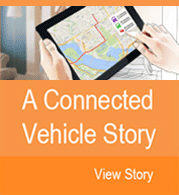Resources
Connected vehicle technology will enable vehicles, roads and other infrastructure, and our smartphones to all communicate and share vital transportation information. The communication flows will be based primarily on a networking technology known as dedicated short-range communications (DSRC), which is similar to Wi-Fi. Many vehicles today are already "connected" through cellular technology. DSRC offers unique opportunities for fast, secure, and reliable communications, and is not vulnerable to interference. Learn about DSRC in the DSRC Fact Sheet.
Basically, your vehicle, and eventually practically every other vehicle on the road, will use DSRC, as well as GPS, cellular, Bluetooth, and other communications systems, to attain 360-degree awareness of nearby vehicles. This equipment will continually transmit your position, direction, and speed (e.g., whether you were turning or putting on your brakes), as well as other information, to vehicles sharing the road with you. It will even "talk" to equipment installed in the road itself and other infrastructure, such as traffic signals, stop signs, toll booths, work or school zones, and railroad crossings.
To function safely, a connected vehicle system needs to ensure the trustworthiness of communication between vehicles. The source of each message needs to be trusted and message content needs to be protected from outside interference. The system as contemplated will contain several layers of security and privacy protection to ensure that vehicles can rely on messages sent from other vehicles. The U.S. Department of Transportation"s (USDOT) Intelligent Transportation System Joint Program Office (ITS JPO) is working with the industry to develop tight controls to prevent tampering with connected vehicle hardware and software. The National Highway Traffic Safety Administration (NHTSA) will thoroughly vet tests results.
In addition, the USDOT understands that privacy is a critical concern. Equipment and devices will not identify you or your vehicle. The information they collect and share will be anonymous.
Another key point is that work is being done to ensure the warnings you receive when driving don't become distracting. You will only receive alerts and notifications when a dangerous situation is developing.

|

|

|
















